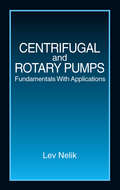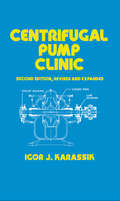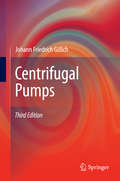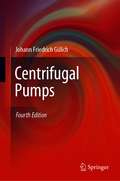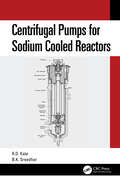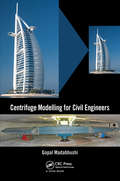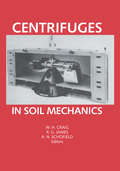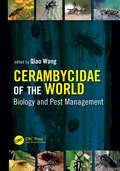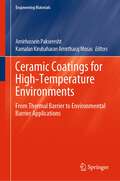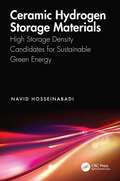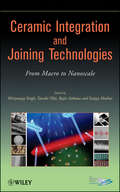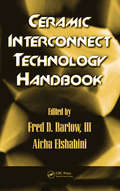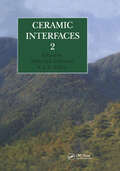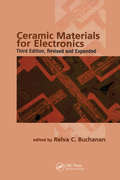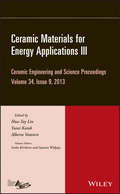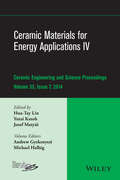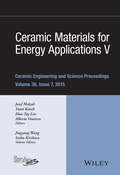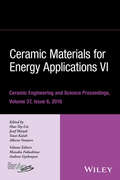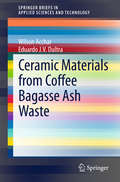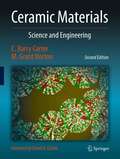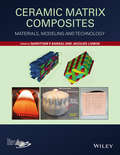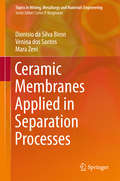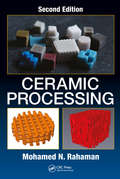- Table View
- List View
Centrifugal & Rotary Pumps: Fundamentals With Applications
by Lev NelikCentrifugal and Rotary Pumps offers both professionals and students a concise reference detailing the design, performance, and principles of operation of the different pumps types defined by the Hydraulic Institute. From historical background to the latest trends and technological developments, the author focuses on information with real-world prac
Centrifugal Pump Clinic, Revised and Expanded (Mechanical Engineering #68)
by Igor J. KarassikMaintaining the excellent coverage of centrifugal pumps begun in the First Edition -- called ``useful'' and ``indispensable'' by reviewers -- the Second Edition continues to serve as the most complete and up-to-date working guide yet written for plant and design engineers involved with centrifugal pumps.
Centrifugal Pumps
by Johann Friedrich GülichThis book gives an unparalleled, up-to-date, in-depth treatment of all kinds of flow phenomena encountered in centrifugal pumps including the complex interactions of fluid flow with vibrations and wear of materials. The scope includes all aspects of hydraulic design, 3D-flow phenomena and partload operation, cavitation, numerical flow calculations, hydraulic forces, pressure pulsations, noise, pump vibrations (notably bearing housing vibration diagnostics and remedies), pipe vibrations, pump characteristics and pump operation, design of intake structures, the effects of highly viscous flows, pumping of gas-liquid mixtures, hydraulic transport of solids, fatigue damage to impellers or diffusers, material selection under the aspects of fatigue, corrosion, erosion-corrosion or hydro-abrasive wear, pump selection, and hydraulic quality criteria. As a novelty, the 3rd ed. brings a fully analytical design method for radial impellers, which eliminates the arbitrary choices inherent to former design procedures. The discussions of vibrations, noise, unsteady flow phenomena, stability, hydraulic excitation forces and cavitation have been significantly enhanced. To ease the use of the information, the methods and procedures for the various calculations and failure diagnostics discussed in the text are gathered in about 150 pages of tables which may be considered as almost unique in the open literature. The text focuses on practical application in the industry and is free of mathematical or theoretical ballast. In order to find viable solutions in practice, the physical mechanisms involved should be thoroughly understood. The book is focused on fostering this understanding which will benefit the pump engineer in industry as well as academia and students.
Centrifugal Pumps
by Johann Friedrich GülichThis handbook summarizes the research results on hydraulic problems in centrifugal pump design and describes the state of the art in a comprehensive way. For this 4th edition, current research results of practical relevance were included. The selection and presentation of the material was oriented towards the needs of pump manufacturers, system planners and pump operators. Much space is devoted to understanding the physical relationships as essential knowledge for correct application. The latter is supported by more than 160 diagrams and tables for calculation and problem diagnosis . The book has been extensively updated. New additions: - A separate chapter on "Vibrations on vertical pumps". - Measurements of hydraulic exciter and impeller reaction forces - Alternating stresses and fatigue fractures of impellers - a critical study on the accuracy of numerical flow calculations of pumps - Design of inlet housings and double spirals for multistage pumps.
Centrifugal Pumps for Sodium Cooled Reactors
by Ravindra Kale B.K. ShreedharThis comprehensive introduction to centrifugal pumps used in sodiumcooled fast reactors discusses the special attributes of centrifugal pumps, design features, manufacturing requirements, instrumentation, and operating experience. It covers the characteristics of mechanical pumps, used as the main coolant pumps in fast reactors. Key Features: • Covers description of pumps in various reactors highlighting the special features of the pumps and providing an overview of futuristic design concepts. • Discusses the aspects related to the design, manufacture, testing, instrumentation, and operating experience of centrifugal sodium pumps. • Highlights the challenges in centrifugal sodium pump testing. • Presents topics such as cavitation testing for critical applications and thermodynamic effect on pump cavitation. • Real-life case studies are included for better understanding. This book gives a detailed overview of the design, manufacture, testing, and operating experience of the main coolant pumps used in sodium-cooled nuclear reactors. It further discusses the special type of pumps used in fast reactor power plants to circulate liquid sodium through the core. The text examines the challenges in centrifugal sodium pump testing and types of test facilities around the world. Real-life examples are used to highlight important aspects. It is primarily written for senior undergraduate, graduate students, and academic researchers in the fields such as mechanical engineering, nuclear engineering, and chemical engineering.
Centrifuge Modelling for Civil Engineers
by Gopal Madabhushi<p>Presenting more than 25 years of teaching and working experience in a wide variety of centrifuge testing, the author of Centrifuge Modelling for Civil Engineers fills a need for information about this field. This text covers all aspects of centrifuge modelling. Expertly explaining the basic principles, the book makes this technique accessible to practicing engineers and researchers. <p>Civil engineers that are new to the industry can refer to this material to solve complex geotechnical problems. The book outlines a generalized design process employed for civil engineering projects. It begins with the basics, and then moves on to increasingly complex methods and applications including shallow foundations, retaining walls, pile foundations, tunnelling beneath existing pile foundations, and assessing the stability of buildings and their foundations following earthquake-induced soil liquefaction. It addresses the use of modern imaging technique, data acquisition, and modelling techniques. It explains the necessary signal processing tools that are used to decipher centrifuge test data, and introduces the reader to the specialist aspects of dynamic centrifuge modelling used to study dynamic problems such as blast, wind, or wave loading with emphasis on earthquake engineering including soil liquefaction problems. <p> <li>Introduces the equipment and instrumentation used in centrifuge testing <li>Presents in detail signal processing techniques such as smoothing and filtering <li>Provides example centrifuge data that can be used for sample analysis and interpretation</li> <p> <p>Centrifuge Modelling for Civil Engineers effectively describes the equipment, instrumentation, and signal processing techniques required to make the best use of the centrifuge modelling and test data. This text benefits graduate students, researchers, and practicing civil engineers involved with geotechnical issues.</p>
Centrifuges in Soil Mechanics
by R.G.JAMES and A.N.SCHOFIELDThis book contains technical papers, presented in a discussion session at the XI International Conference on Soil Mechanics and Foundation Engineering held in San Francisco in 1985, on the role of centrifuge in geotechnical testing, with descriptions of test facilities.
Cerambycidae of the World: Biology and Pest Management (Contemporary Topics in Entomology)
by Qiao WangWang has gathered contributions from an impressive cohort of the world’s most respected experts on longhorned beetles. Chapters review both basics of cerambycid taxonomy, mor- phology, and behavior (feeding, reproduction, and chemical ecology), as well as more applied concerns, such as laboratory rearing, pest control, and bio- security. Overall, this volume is a valuable contribution to the literature as a "one-stop shop" for readers seeking a comprehensive overview of longhorned beetles... It represents a tremendous effort on the part of Wang and the authors, and has resulted in a much-needed update to the literature. This volume is the only work of its kind available at this time, and is a valuable addition to the library of any scientist studying wood-boring beetles. - Ann M. Ray, Biology, Xavier University, Cincinnati, Ohio in The Quarterly Review of Biology, Volume 94, 2019 There are more than 36,000 described species in the family Cerambycidae in the world. With the significant increase of international trade in the recent decades, many cerambycid species have become major plant pests outside their natural distribution range, causing serious environmental problems at great cost. Cerambycid pests of field, vine, and tree crops and of forest and urban trees cost billions of dollars in production losses, damage to landscapes, and management expenditures worldwide. Cerambycidae of the World: Biology and Pest Management is the first comprehensive text dealing with all aspects of cerambycid beetles in a global context. It presents our current knowledge on the biology, classification, ecology, plant disease transmission, and biological, cultural, and chemical control tactics including biosecurity measures from across the world. Written by a team of global experts, this book provides an entrance to the scientific literature on Cerambycidae for scientists in research institutions, primary industries, and universities, and will serve as an essential reference for agricultural and quarantine professionals in governmental departments throughout the world.
Ceramic Coatings for High-Temperature Environments: From Thermal Barrier to Environmental Barrier Applications (Engineering Materials)
by Amirhossein Pakseresht Kamalan Kirubaharan Amirtharaj MosasThis book addresses the recent trends in thermal and environmental barrier coatings and their applications in extreme environments. It introduces the state of the art in coating materials and processes for high and ultrahigh-temperature environments and identifies areas for improvement in materials selection, performance upgrades, design considerations, and manufacturing methods. This book also covers fundamental studies involving modelling, creating coating architectures, coating preparation methods, and coating capability throughout a wide temperature range. The book examines a variety of high-temperature coatings prepared through various synthesis processes such as thermal spraying, electron beam evaporation, and sol–gel methods. This book also covers ultrahigh-temperature ceramic (UHTC) materials and provides a brief overview of the synthesis method, densification processes, and coating methods along with the properties and applications of emerging high entropy UHTCs. With contributions from international researchers active in the field, this edited book features the most recent and up-to-date literature references for a broad readership consisting of academic and industrial professionals. It is suitable for graduate students as well as materials scientists and engineers working in the area of high and ultrahigh-temperature ceramic materials.
Ceramic Hydrogen Storage Materials: High Storage Density Candidates for Sustainable Green Energy
by Navid HosseinabadiCeramic Hydrogen Storage Materials presents the physical, chemical, physico-chemical properties of ceramics as hydrogen storage materials. It demonstrates how ceramic nanostructures can be specifically designed for high surface adsorption of hydrogen and can function as hydrogen batteries.Covering methods for characterizing hydrogen storage capacity, this book showcases how hydrogen has the potential to facilitate decarbonization of the electric power sector by storing energy produced from renewable sources. It addresses both ceramic oxides and non-oxides while expanding on the synthesis and characterization of zero- and one-dimensional, high-surface-area ceramic structures. This book discusses the applications of hydrogen batteries in zero-emission vehicles and hydrogen fuels for aircraft.This book will interest upper-level undergraduate energy and materials engineering students, as well as researchers studying green energy storage materials, hydrogen storage, and alternative transportation fuels.
Ceramic Integration and Joining Technologies
by Sanjay Mathur Rajiv Asthana Mrityunjay Singh Tatsuki OhjiThis book joins and integrates ceramics and ceramic-based materials in various sectors of technology. A major imperative is to extract scientific information on joining and integration response of real, as well as model, material systems currently in a developmental stage.This book envisions integration in its broadest sense as a fundamental enabling technology at multiple length scales that span the macro, millimeter, micrometer and nanometer ranges. Consequently, the book addresses integration issues in such diverse areas as space power and propulsion, thermoelectric power generation, solar energy, micro-electro-mechanical systems (MEMS), solid oxide fuel cells (SOFC), multi-chip modules, prosthetic devices, and implanted biosensors and stimulators. The engineering challenge of designing and manufacturing complex structural, functional, and smart components and devices for the above applications from smaller, geometrically simpler units requires innovative development of new integration technology and skillful adaptation of existing technology.
Ceramic Interconnect Technology Handbook
by Fred D. Barlow and Aicha ElshabiniCeramics were among the first materials used as substrates for mass-produced electronics, and they remain an important class of packaging and interconnect material today. Most available information about ceramic electronics is either outdated or focused on their materials science characteristics. The Ceramic Interconnect Technology Handbook goes beyond the traditional approach by first surveying the unique properties of ceramics and then discussing design, processing, fabrication, and integration, as well as packaging and interconnect technologies.Collecting contributions from an outstanding panel of experts, this book offers an up-to-date overview of modern ceramic electronics, from design and material selection to manufacturing and implementation. Beginning with an overview of the development, properties, advantages, and applications of ceramics, coverage spans electrical design, testing, simulation, thermomechanical design, screen printing, multilayer ceramics, photo-defined and photo-imaged films, copper interconnects for ceramic substrates, and integrated passive devices in ceramic substrates. It also offers a detailed review of the surface, thermal, mechanical, and electrical properties of various ceramics as well as the processing of high- and low-temperature cofired ceramic (HTCC and LTCC) substrates.Opening new vistas and avenues of advancement, the Ceramic Interconnect Technology Handbook is the only source for comprehensive discussion and analysis of nearly every facet of ceramic interconnect technology and applications.
Ceramic Interfaces 2
by Kim Ill YooThe science of ceramic interfaces is multidisciplinary, overlapping several existing, well-established disciplines such as solid-state chemistry, high-temperature chemistry, solid-state electrochemistry, surface science, catalysis and metallurgy. This volume contains the processing’s of the 4th international workshop on ceramic Interfaces held at the Korea Advanced Institute of Science and Technology, Taejon, Korea. 27 specialists from 8 countries contributed of the workshop which was divided into 3 sessions: Microstructural development; Transport; Interfacial Phenomena and Kinetics.
Ceramic Lasers
by Akio Ikesue Yan Lin Aung Voicu Lupei Akio Ikesue Yan Lin Aung Voicu LupeiUntil recently, ceramic materials were considered unsuitable for optics due to the numerous scattering sources, such as grain boundaries and residual pores. However, in the 1990s the technology to generate a coherent beam from ceramic materials was developed, and a highly efficient laser oscillation was realized. In the future, the technology derived from the development of the ceramic laser could be used to develop new functional passive and active optics. Co-authored by one of the pioneers of this field, the book describes the fabrication technology and theoretical characterization of ceramic material properties. It describes novel types of solid lasers and other optics using ceramic materials to demonstrate the application of ceramic gain media in the generation of coherent beams and light amplification. This is an invaluable guide for physicists, materials scientists and engineers working on laser ceramics.
Ceramic Materials for Electronics
by Relva C. BuchananThe Third Edition of Ceramic Materials for Electronics studies a wide range of ceramic materials, including insulators, conductors, piezoelectrics, and ferroelectrics, through detailed discussion of their properties, characterization, fabrication, and applications in electronics. The author summarizes the latest trends and advancements in the field, and explores important topics such as ceramic thin film, functional device technology, and thick film technology. Edited by a leading expert on the subject, this new edition includes more than 150 pages of new information; restructured reference materials, figures, and tables; as well as additional device application-oriented segments.
Ceramic Materials for Energy Applications III: Ceramic Engineering and Science Proceedings, Volume 34 Issue 9
by Soshu Kirihara Sujanto Widjaja Hua-Tay Lin Yutai Katoh Alberto VomieroCeramic Engineering and Science Proceedings Volume 34, Issue 9 - Ceramic Materials for Energy Applications III A collection of 15 papers from The American Ceramic Society's 37th International Conference on Advanced Ceramics and Composites, held in Daytona Beach, Florida, January 27-February 1, 2013. This issue includes papers presented in Symposia 6 -Advanced Materials and Technologies for Rechargeable Energy Storage; Symposium13 - Advanced Ceramics and Composites for Sustainable Nuclear Energy and FusionEnergy; Focused Session 4 - Advanced Processing for Photonics and Energy; andthe Engineering Summit of the Americas session.
Ceramic Materials for Energy Applications IV: Ceramic Engineering and Science Proceedings, Volume 35 Issue 7
by Andrew L. Gyekenyesi Hua-Tay Lin Yutai Katoh Josef Matyas Michael HalbigA collection of 14 papers from The American Ceramic Society's 38th International Conference on Advanced Ceramics and Composites, held in Daytona Beach, Florida, January 26-31, 2014. This issue includes papers presented in Symposia 6 - Advanced Materials and Technologies for Energy Generation, Conversion, and Rechargeable Energy Storage and Symposium 13 - Advanced Ceramics and Composites for Sustainable Nuclear Energy and Fusion Energy.
Ceramic Materials for Energy Applications V: Ceramic Engineering and Science Proceedings, Volume 36 Issue 7
by Soshu Kirihara Jingyang Wang Hua-Tay Lin Yutai Katoh Alberto Vomiero Josef MatyasThe Ceramic Engineering and Science Proceeding has been published by The American Ceramic Society since 1980. This series contains a collection of papers dealing with issues in both traditional ceramics (i. e. , glass, whitewares, refractories, and porcelain enamel) and advanced ceramics. Topics covered in the area of advanced ceramic include bioceramics, nanomaterials, composites, solid oxide fuel cells, mechanical properties and structural design, advanced ceramic coatings, ceramic armor, porous ceramics, and more.
Ceramic Materials for Energy Applications VI
by Hua-Tay Lin Yutai Katoh Alberto Vomiero Manabu Fukushima Andrew Gyekenyesi Josef MatyášA collection of 15 papers from The American Ceramic Society’s 40th International Conference on Advanced Ceramics and Composites, held in Daytona Beach, Florida, January 24-29, 2016. This issue includes papers presented in Symposia 6 - Advanced Materials and Technologies for Energy Generation, Conversion, and Rechargeable Energy Storage; Symposium 13 - Advanced Ceramics and Composites for Sustainable Nuclear Energy and Fusion Energy, and Focused Session 2 – Advanced Ceramic Materials and Processing for Photonics and Energy.
Ceramic Materials from Coffee Bagasse Ash Waste (SpringerBriefs in Applied Sciences and Technology)
by Wilson Acchar Eduardo J. V. DultraThis book proposes the use of coffee bagasse ash (CBA) waste as raw material to be used in ceramic formulations. The approach presented here is a solution to a current ambiental problem as CBA waste is discharged in high amounts in agriculture. The authors analyze the potencial of CBA as a material to substitute feldspar in tile production.
Ceramic Materials: Science and Engineering
by C. Barry Carter M. Grant NortonCeramic Materials: Science and Engineering is an up-to-date treatment of ceramic science, engineering, and applications in a single, comprehensive text. Building on a foundation of crystal structures, phase equilibria, defects, and the mechanical properties of ceramic materials, students are shown how these materials are processed for a wide diversity of applications in today's society. Concepts such as how and why ions move, how ceramics interact with light and magnetic fields, and how they respond to temperature changes are discussed in the context of their applications. References to the art and history of ceramics are included throughout the text, and a chapter is devoted to ceramics as gemstones. This course-tested text now includes expanded chapters on the role of ceramics in industry and their impact on the environment as well as a chapter devoted to applications of ceramic materials in clean energy technologies. Also new are expanded sets of text-specific homework problems and other resources for instructors. The revised and updated Second Edition is further enhanced with color illustrations throughout the text.
Ceramic Matrix Composites
by Narottam P. Bansal Jacques LamonThis book is a comprehensive source of information on various aspects of ceramic matrix composites (CMC). It covers ceramic and carbon fibers; the fiber-matrix interface; processing, properties and industrial applications of various CMC systems; architecture, mechanical behavior at room and elevated temperatures, environmental effects and protective coatings, foreign object damage, modeling, life prediction, integration and joining. Each chapter in the book is written by specialists and internationally renowned researchers in the field. This book will provide state-of-the-art information on different aspects of CMCs. The book will be directed to researchers working in industry, academia, and national laboratories with interest and professional competence on CMCs. The book will also be useful to senior year and graduate students pursuing degrees in ceramic science and engineering, materials science and engineering, aeronautical, mechanical, and civil or aerospace engineering.Presents recent advances, new approaches and discusses new issues in the field, such as foreign object damage, life predictions, multiscale modeling based on probabilistic approaches, etc.Caters to the increasing interest in the application of ceramic matrix composites (CMC) materials in areas as diverse as aerospace, transport, energy, nuclear, and environment. CMCs are considered ans enabling technology for advanced aeropropulsion, space propulsion, space power, aerospace vehicles, space structures, as well as nuclear and chemical industries.Offers detailed descriptions of ceramic and carbon fibers; fiber-matrix interface; processing, properties and industrial applications of various CMC systems; architecture, mechanical behavior at room and elevated temperatures, environmental effects and protective coatings, foreign object damage, modeling, life prediction, integration/joining.
Ceramic Membranes Applied in Separation Processes
by Dionisio da Silva Biron Venina Dos Santos Mara ZeniThis book covers diverse types of ceramic membranes applied in separation processes. The authors present the preparation methods and well as the main application of ceramic membranes. Modules, microfiltration and ultrafiltration are topics described within the text. The final chapter focuses on water and wastewater treatment by membranes separation processes.
Ceramic Processing
by Mohamed N. RahamanMaterials scientists continue to develop stronger, more versatile ceramics for advanced technological applications, such as electronic components, fuel cells, engines, sensors, catalysts, superconductors, and space shuttles. From the start of the fabrication process to the final fabricated microstructure, Ceramic Processing covers all aspects of modern processing for polycrystalline ceramics. Stemming from chapters in the author's bestselling text, Ceramic Processing and Sintering, this book gathers additional information selected from many sources and review articles in a single, well-researched resource. The author outlines the most commonly employed ceramic fabrication processes by the consolidation and sintering of powders. A systematic approach highlights the importance of each step as well as the interconnection between the various steps in the overall fabrication route. The in-depth treatment of production methods includes powder, colloidal, and sol-gel processing as well as chemical synthesis of powders, forming, sintering, and microstructure control. The book covers powder preparation and characterization, organic additives in ceramic processing, mixing and packing of particles, drying, and debinding. It also describes recent technologies such as the synthesis of nanoscale powders and solid freeform fabrication. Ceramic Processing provides a thorough foundation and reference in the production of ceramic materials for advanced undergraduates and graduate students as well as professionals in corporate training or professional courses.
Ceramic Processing
by Mohamed N. RahamanMany of the properties critical to the engineering applications of ceramics are strongly dependent on their microstructure which, in turn, is dependent on the processing methods used to produce the ceramic material. Ceramic Processing, Second Edition provides a comprehensive treatment of the principles and practical methods used in producing ceramics with controlled microstructure. Covering the main steps in the production of ceramics from powders, the book also provides succinct coverage of other methods for fabricating ceramics, such as sol−gel processing, reaction bonding, chemical vapor deposition and polymer pyrolysis. While maintaining the objectives of the successful first edition, this new edition has been revised and updated to include recent developments and expanded to feature new chapters on additives used in ceramic processing; rheological properties of suspensions, slurries, and pastes; granulation, mixing, and packing of particles; and sintering theory and principles. Intended as a textbook for undergraduate and graduate courses in ceramic processing, the book also provides an indispensable resource for research and development engineers in industry who are involved in the production of ceramics or who would like to develop a background in the processing of ceramics.
